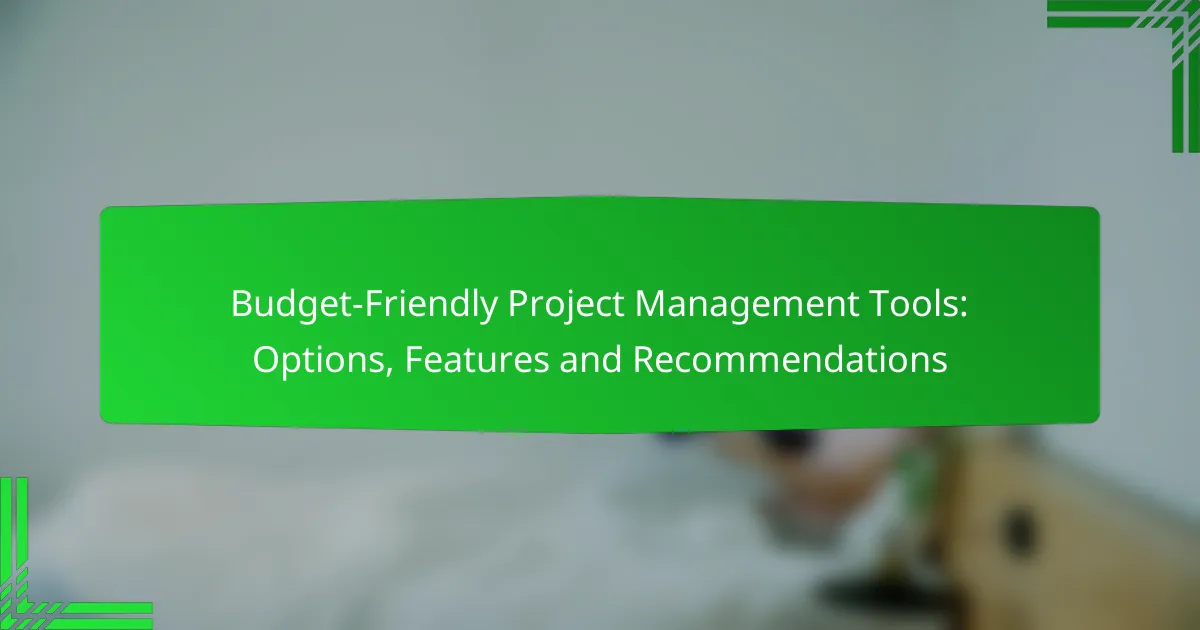Finding the right budget-friendly project management tool can significantly enhance your team’s productivity without breaking the bank. Options like Trello, Asana, ClickUp, Wrike, and Monday.com offer essential features for task organization, progress tracking, and team collaboration. By focusing on key functionalities such as task management, collaboration tools, and reporting capabilities, you can streamline your project workflows effectively.

What are the best budget-friendly project management tools?
The best budget-friendly project management tools provide essential features for organizing tasks, tracking progress, and collaborating with teams without incurring high costs. Popular options include Trello, Asana, ClickUp, Wrike, and Monday.com, each offering unique functionalities suited for different project needs.
Trello
Trello is a visual project management tool that uses boards, lists, and cards to help teams organize tasks. It is particularly effective for small to medium-sized projects due to its simplicity and ease of use.
With a free tier that includes unlimited boards and cards, Trello is an excellent choice for teams looking to manage workflows without spending money. However, advanced features like automation and integrations may require a paid plan.
Asana
Asana is a versatile project management platform that allows teams to plan, track, and manage work efficiently. It offers a user-friendly interface with features such as task assignments, deadlines, and project timelines.
The free version of Asana supports up to 15 users, making it suitable for small teams. For larger projects or additional features like timeline views and reporting, consider upgrading to a premium plan.
ClickUp
ClickUp is an all-in-one project management tool that combines task management, document sharing, and goal tracking. Its customizable features allow teams to tailor the platform to their specific workflows.
ClickUp offers a free plan with essential features, while paid plans provide advanced functionalities like time tracking and integrations. This flexibility makes it a strong contender for teams of various sizes and needs.
Wrike
Wrike is a robust project management solution designed for teams that require detailed project tracking and reporting. It includes features like Gantt charts, time tracking, and workload management.
Wrike’s free plan is limited to five users, making it ideal for small teams. For larger organizations or those needing more advanced features, paid plans are available, offering enhanced collaboration tools and reporting capabilities.
Monday.com
Monday.com is a highly visual project management tool that helps teams collaborate and manage tasks through customizable workflows. Its intuitive interface allows users to create boards tailored to their project needs.
While Monday.com does not offer a free tier, its pricing is competitive, and it provides a 14-day free trial. This allows teams to explore its features before committing to a subscription, making it a good option for those seeking a comprehensive solution.

What features should I look for in a budget project management tool?
When selecting a budget project management tool, prioritize features that enhance productivity without excessive costs. Key functionalities include task management, collaboration tools, time tracking, reporting capabilities, and integrations, which collectively streamline project workflows.
Task management
Effective task management is crucial for organizing project activities. Look for tools that allow you to create, assign, and prioritize tasks easily. Features like due dates, checklists, and progress tracking can help keep your team on schedule.
Consider tools that offer visual task boards, such as Kanban or Gantt charts, which can improve clarity on project timelines and responsibilities. This visual representation can enhance team engagement and accountability.
Collaboration tools
Collaboration features facilitate communication among team members, which is essential for project success. Tools should provide options for real-time messaging, file sharing, and discussion threads to keep everyone aligned.
Look for platforms that integrate with popular communication apps like Slack or Microsoft Teams. This integration can streamline workflows and reduce the need to switch between different applications.
Time tracking
Time tracking capabilities help monitor how much time is spent on tasks, which is vital for budgeting and resource allocation. Choose tools that allow easy logging of hours and provide insights into time usage across projects.
Some tools offer automated time tracking features that start when work begins and stop when it ends. This can reduce manual entry errors and provide more accurate data for project assessments.
Reporting capabilities
Robust reporting features enable you to analyze project performance and make informed decisions. Look for tools that offer customizable reports on task completion, time spent, and resource allocation.
Consider tools that provide visual analytics, such as charts and graphs, to quickly identify trends and areas needing improvement. This can help in adjusting strategies and enhancing overall project efficiency.
Integrations
Integration with other software is essential for a seamless workflow. Ensure the project management tool can connect with applications your team already uses, such as email, calendars, and file storage services.
Common integrations include Google Drive for file sharing and Zapier for automating repetitive tasks. These connections can save time and reduce the complexity of managing multiple tools.

How do budget project management tools compare in pricing?
Budget project management tools vary widely in pricing, often offering tiered plans that cater to different team sizes and feature needs. Most tools provide free versions with limited features, while paid plans can range from low monthly fees to more substantial costs depending on functionality and user count.
Trello pricing plans
Trello offers a free plan that includes basic features suitable for small teams. Paid plans start at around $5 per user per month, providing additional features like automation and advanced integrations. The Business Class plan, priced at approximately $10 per user per month, includes enhanced collaboration tools and priority support.
Asana pricing plans
Asana has a free tier for teams of up to 15 members, which includes essential task management features. Paid plans begin at about $10.99 per user per month, unlocking advanced features such as timeline views and reporting tools. The Business plan, costing around $24.99 per user per month, adds even more capabilities like custom fields and portfolios.
ClickUp pricing plans
ClickUp offers a free version with a comprehensive set of features, making it a strong option for budget-conscious teams. Paid plans start at approximately $5 per user per month, which includes additional functionalities like time tracking and integrations. The Business plan, priced at around $12 per user per month, provides even more advanced features such as goal tracking and custom dashboards.
Wrike pricing plans
Wrike’s free plan is limited to five users and includes basic project management tools. Paid plans begin at about $9.80 per user per month, offering features like Gantt charts and time tracking. The Business plan, which costs around $24.80 per user per month, includes advanced reporting and custom workflows, ideal for larger teams.
Monday.com pricing plans
Monday.com starts with a free plan for up to two users, which includes basic features. Paid plans begin at around $8 per user per month, offering more functionalities such as automation and integrations. The Pro plan, priced at approximately $16 per user per month, adds advanced features like time tracking and reporting, making it suitable for growing teams.

What are the pros and cons of using free project management tools?
Free project management tools offer significant advantages such as cost savings and accessibility, but they also come with drawbacks like limited features and support. Understanding these pros and cons can help teams decide if a free tool meets their project needs.
Cost savings
One of the main benefits of using free project management tools is the cost savings they provide. Organizations can avoid subscription fees, which can range from tens to hundreds of dollars per month, depending on the tool and the number of users.
This financial relief allows teams, especially startups and small businesses, to allocate resources to other critical areas, such as marketing or product development. However, it’s essential to weigh these savings against potential limitations in functionality.
Limited features
Free project management tools often come with restricted features compared to their paid counterparts. Users may find that essential functionalities, such as advanced reporting, integrations, or customization options, are either missing or significantly limited.
This can hinder project efficiency and collaboration, especially for larger teams or complex projects. It’s crucial to evaluate whether the available features align with your project requirements before committing to a free tool.
Scalability issues
Scalability is another concern when using free project management tools. As projects grow or teams expand, these tools may struggle to accommodate increased demands, leading to performance issues or a lack of necessary features.
For instance, a tool that works well for a small team may become cumbersome when managing multiple projects or larger teams. Consider your future needs and whether the tool can adapt as your organization evolves.
Support limitations
Support is often limited for free project management tools, which can be a significant drawback. Users may have access to community forums or basic documentation, but direct support from the provider is usually minimal or non-existent.
This lack of support can lead to frustration when users encounter technical issues or need assistance with specific features. If reliable support is a priority for your team, it may be worth investing in a paid tool that offers comprehensive customer service.

How can I choose the right budget project management tool for my team?
To choose the right budget project management tool, assess your team’s specific needs, including project size, collaboration requirements, and budget constraints. Evaluate features like task tracking, reporting, and integration capabilities to find a tool that aligns with your workflow.
Consider your team’s size and project complexity
Your team’s size and the complexity of your projects significantly influence the choice of a project management tool. For smaller teams or simple projects, lightweight tools with basic features may suffice, while larger teams or complex projects often require more robust solutions with advanced functionalities.
For example, if your team consists of fewer than five members and handles straightforward tasks, consider tools like Trello or Asana. However, for teams exceeding ten members or managing multiple projects, platforms like ClickUp or Monday.com may be more appropriate.
Evaluate essential features
When selecting a budget project management tool, prioritize essential features that enhance productivity. Look for capabilities such as task assignment, deadline tracking, file sharing, and communication tools. These features facilitate collaboration and ensure everyone is on the same page.
Additionally, consider tools that offer reporting and analytics to help track project progress and identify bottlenecks. For instance, tools like Wrike and Basecamp provide built-in reporting features that can help you monitor team performance and project timelines effectively.
Assess integration capabilities
Integration capabilities are crucial when choosing a project management tool, as they allow seamless connectivity with other software your team uses. Look for tools that can integrate with communication platforms like Slack or email services, as well as file storage solutions like Google Drive or Dropbox.
For example, if your team relies heavily on Google Workspace, selecting a tool that integrates well with Google Calendar and Docs can streamline your workflow and reduce the need for switching between applications.
Set a budget and compare options
Establishing a budget is vital when selecting a project management tool. Many budget-friendly options are available, ranging from free plans with limited features to affordable monthly subscriptions. Determine what features are essential for your team and how much you are willing to spend.
Compare different tools based on their pricing structures and features. Tools like Trello offer free plans, while others like Asana and ClickUp provide tiered pricing based on the number of users and features required. This comparison will help you identify the best value for your team’s needs.
